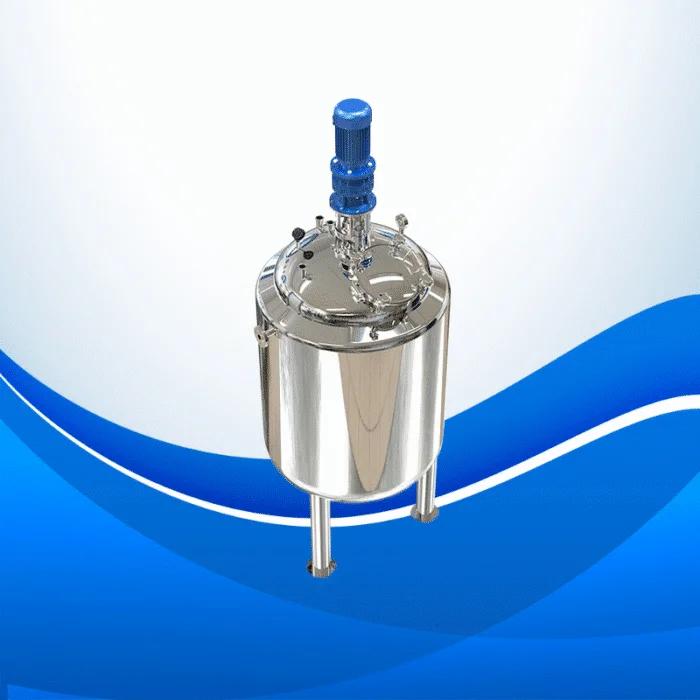The food and beverage industry thrives on consistency, quality, and safety. From the initial stages of production to packaging, every aspect of the process must be meticulously controlled to ensure the end product meets high standards. One essential tool that plays a pivotal role in achieving this consistency is the Jacket Mixing Tank.
What Is a Jacket Mixing Tank?
A Jacket Mixing Tank is a type of industrial equipment designed to mix and heat substances simultaneously. The tank is equipped with a heating jacket that surrounds the tank, providing precise control over the temperature of the contents. This function is crucial for processes that require constant or gradual heating, such as mixing ingredients for sauces, beverages, or dairy products.
In addition to heating, the tank also features an internal mixing mechanism that helps blend ingredients thoroughly, ensuring a uniform mixture. The combination of these two functions makes the Jacket Mixing Tank a staple in food and beverage manufacturing.
Why Temperature Control Matters in Food Processing
Temperature plays a critical role in food processing. Many food products require specific temperature conditions to maintain their flavour, texture, and nutritional value. For example, sauces and soups require precise temperature control to avoid overcooking or undercooking, which can impact both taste and texture.
A Jacket Mixing Tank offers an efficient solution to this challenge. By using its built-in heating jacket, manufacturers can precisely control the temperature of the contents. This is especially important in processes such as pasteurisation, which requires heating liquids to a specific temperature for a set period before cooling them.
The heating jacket ensures that the entire mixture is heated evenly, preventing any areas from overheating or becoming too cold. This uniformity is crucial for maintaining the integrity of the food product and ensuring compliance with safety regulations.
Improving Product Consistency with Jacket Mixing Tanks
One of the most significant challenges in food and beverage processing is maintaining consistent product quality. Ingredients may vary from batch to batch, and even slight variations in temperature or mixing speed can result in noticeable differences in the final product.
The Jacket Mixing Tank addresses this issue by providing precise temperature control and even mixing. The heating jacket ensures that the product is heated evenly throughout the mixing process, preventing any inconsistencies. Additionally, the internal mixing mechanism ensures that all ingredients are blended thoroughly, reducing the risk of clumping or separation.
For manufacturers, this translates to greater efficiency and less waste. By ensuring that each batch is consistent, they can reduce the need for costly rework or disposal of defective products. This makes Jacket Mixing Tanks a valuable asset in any food and beverage production line.
Versatility of Jacket Mixing Tanks in Food Production
The versatility of jacketed mixing Tanks is another reason they are essential in the food and beverage industry. These tanks can be used for a wide range of products, including sauces, soups, dairy products, beverages, and confectionery. Their ability to handle both heating and mixing simultaneously makes them an efficient solution for many different food production processes.
For example, in dairy production, Jacket Mixing Tanks are used to blend milk, cream, and other ingredients while maintaining the proper temperature to ensure the right texture and consistency. In beverage production, these tanks are crucial for mixing fruit concentrates, syrups, and water while maintaining the perfect temperature for blending and pasteurisation.
Additionally, the Jacket Mixing Tank can be adapted to meet various production needs. Manufacturers can choose tanks with different sizes, heating capacities, and mixing speeds to match the specific requirements of their products. This flexibility makes the Jacket Mixing Tank a valuable asset for any food production line, regardless of the product being manufactured.
The Importance of Hygiene in Food Processing
In the food and beverage industry, hygiene is paramount. Contamination can lead to product spoilage and even foodborne illnesses. A key advantage of Jacket Mixing Tanks is that they are designed with hygiene in mind. The materials used in their construction, such as stainless steel, are resistant to corrosion and easy to clean.
The smooth surfaces of the Jacket Mixing Tank ensure that food products don’t get trapped in crevices or corners, which could otherwise lead to bacterial growth. The design of these tanks allows for easy cleaning between batches, helping manufacturers maintain the highest hygiene standards.
Enhanced Efficiency and Cost-Effectiveness
Another significant benefit of Jacket Mixing Tanks is their impact on production efficiency. By combining mixing and heating in one piece of equipment, manufacturers can streamline their production process. Instead of using separate tanks for heating and mixing, the Jacket Mixing Tank enables both processes to co-occur, thereby reducing the overall time required for production.
This improved efficiency leads to faster production cycles, resulting in increased output and reduced operational costs. Additionally, the precise temperature control provided by the heating jacket ensures that energy is used more efficiently. This helps manufacturers save on energy costs while maintaining consistent product quality.
Environmental Benefits of Jacket Mixing Tanks
Sustainability is becoming increasingly important in the food and beverage industry. Manufacturers are under pressure to reduce their environmental footprint while maintaining high production standards. The energy efficiency of Jacket Mixing Tanks plays a significant role in helping meet these sustainability goals.
By using a heating jacket to maintain the desired temperature, these tanks reduce the need for excess energy usage. This helps minimise waste and lowers the carbon footprint of the production process. For businesses focused on sustainability, investing in energy-efficient equipment, such as the Jacket Mixing Tank, can contribute to a more eco-friendly production process.
Conclusion
The Jacket Mixing Tank plays a vital role in the food and beverage industry, offering solutions for precise temperature control, consistent product quality, and improved production efficiency. Its ability to mix and heat substances simultaneously makes it an indispensable tool for manufacturers seeking to create high-quality, consistent products.
As the industry continues to prioritise efficiency, sustainability, and hygiene, the importance of the Jacket Mixing Tank will only continue to grow. For manufacturers looking to streamline their processes while ensuring top-tier quality, investing in this versatile and reliable equipment is a step toward a more efficient and successful operation.





